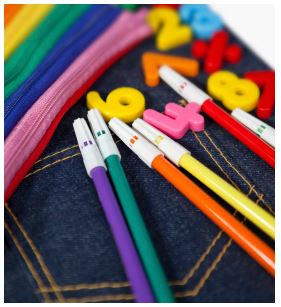Looking at TOYS Through a Therapist’s Eyes!
by Cara Koscinki MOT, OTR/L

Children of all ages learn skills through engaging in play. After all, when children are not asleep they are learning about their environment through various play activities during their day. They enjoy diving hands first into play experiences! Completing the tasks of building blocks, working a puzzle, and drawing pictures will yield skills that the child will use throughout his lifetime. Occupational therapists are fortunate enough to be a critical part of the treatment team for children with special needs. We have developed a specialty called “activity analysis.” This means we work by looking at how an activity is broken down into smaller steps. Therapists who work with children have become experts in looking at different games and toys to determine which skills a child needs to complete them. When the therapist finds a weakness in a particular skill, we can “prescribe” different games or toys to help improve the skill. It is a fun job to have, indeed!
Children are wired to use their senses to develop skills during play. A toy that gives the child something interesting that involves more than one sense will automatically be more enjoyable to him. More pathways to brain development are opened and used. Here is a list of things therapists look at when evaluating a toy:
Out of the POCKET Ideas!
• What does the toy feel like? What is the texture-soft, smooth, rough, hard?
• Does the toy have a scent to it? For example, certain dolls smell like fruits.
• Is the toy colorful? Are the colors bright and bold or pastel and dull?
• Does the child need both hands to manipulate the toy?
• Does the child need to read or recognize letters and numbers to enjoy the toy?
• Is there a lot of figure-ground information? Examples of toys where the ability to
determine what is in the front or background would be mazes, Eye Spy, Puzzles.
• Does the toy make noise?
• Is it a “social” toy? Like a doll house or card games.
• Does the toy require long periods of attention? Board Games
• Does the toy move, vibrate, or shake?
The list above contains a few areas we look at when examining a particular toy. Here’s an example of an analysis of a toy: A child receives a game of Hi Ho Cheery-O. He needs to be able to sit on floor or table for at least 10 minutes to play the game (control of his body) (attention); must be able to refrain from placing the small cherry manipulative into his mouth (impulse control) (age-appropriate mouthing), be able to count (number/cognitive (thinking) skills); be willing to interact with another player (social skills); be able to pick up and place the small cherries into the bucket (fine motor/coordination); be able to place the cherries into the correct colored bucket (color recognition); and be willing to accept that he may win or lose the game. Everyone knows that there are ages listed on most games, but they don’t think much about what skills are necessary and at what age those skills develop.
Remember to think about your child’s developmental age and not her ACTUAL age. For example, she may be 7 but her speech, fine motor skills, and thinking may be delayed by two years. Toys should be purchased for an 5 year old, then and not a 7 year old. Make sure that the toy is not too easy for her or she will become bored with it. I would encourage you to review the tips above and take your child on a fun visit to the toy store to see what interests her. Teacher supply stores are also full of ecuational treasures. Therapy catalogues and on-line stores such asFunandFunction offer wonderful toys in a way that’s easily searched and at reasonable prices.
It’s important for our children to be successful with a toy to build their confidence for learning newer, more difficult skills!
HAPPY SHOPPING!
About the Author: CCara Koscinski received her Master’s degree in Occupational Therapy in 1997. She is the author of The Pocket Occupational Therapist- a book for caregivers of children with special needs. Cara is also a homeschooling mother to two children with autism and SPD. She was one of the founders of Aspire Pediatric Therapy, LLC. Cara currently owns Route2Greatness, which creates, produces, and distributes CDs for children with auditory sensitivity. The CDs that Cara has created, Sound-Eaze and School-Eaze, are featured in several catalogues for children with special needs. She speaks across the US about autism related topics. Visit her site at www.PocketOT.com
Please Support PediaStaff Contributors and Visit the Pocket Occupational Therapist
PediaStaff is Hiring!
All JobsPediaStaff hires pediatric and school-based professionals nationwide for contract assignments of 2 to 12 months. We also help clinics, hospitals, schools, and home health agencies to find and hire these professionals directly. We work with Speech-Language Pathologists, Occupational and Physical Therapists, School Psychologists, and others in pediatric therapy and education.
